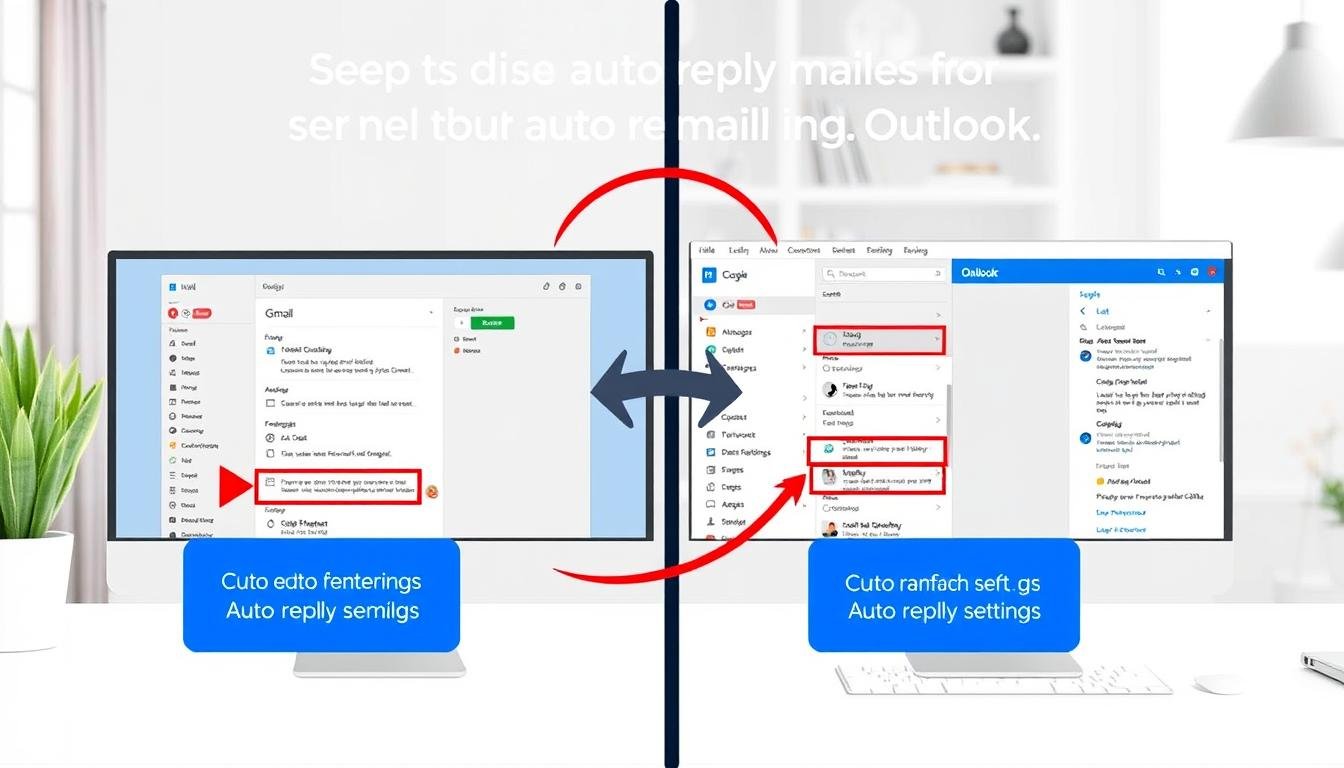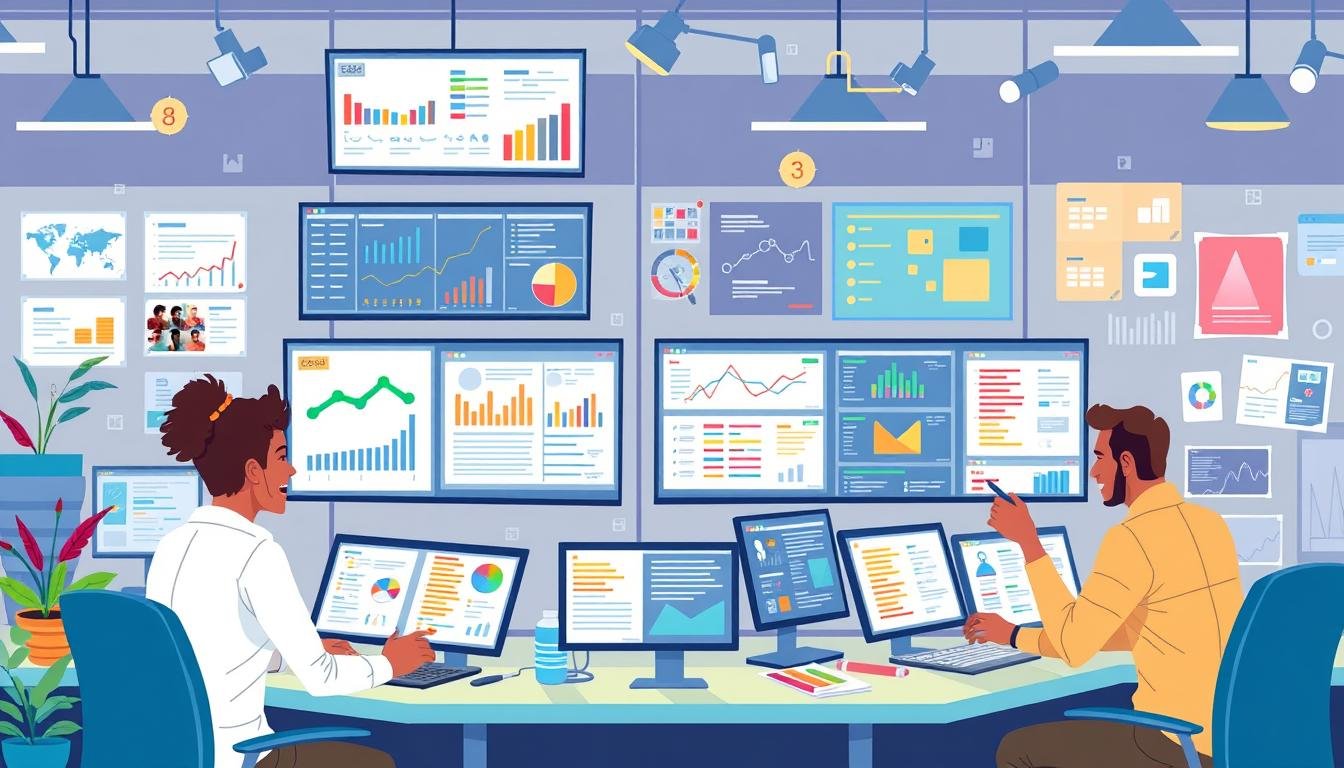In today’s fast world, knowing how to set up auto-reply emails is key. It helps keep communication going, even when I’m not around. This guide will show me how to set up automatic email responses for different times, like vacations or business trips.
With auto-reply messages, I can let my contacts know I’m away. It also helps me look more professional.
Key Takeaways
- 85% of users find auto-reply in Gmail helpful.
- 70% of users use auto-reply in Gmail while on vacation.
- 62% increase in email response efficiency due to auto-reply features.
- Average time saved daily by users with auto-reply is 1 hour.
- 80% feel that auto-reply enhances their professional image.
Introduction to Auto-Reply Emails
Auto-reply emails are key to keeping communication smooth. They let senders know when the recipient is not available, like on vacation or sick leave. Setting up an auto-reply email setup helps keep important messages acknowledged, even when the person is away.
Platforms like Gmail and Outlook make setting up email automation easy. You can use features like ‘Vacation Responder’ in Gmail or automatic replies in Outlook to customize your responses. Auto-responses are great for sharing updates, promoting events, or introducing new products, boosting engagement.
To set up these messages well, follow some best practices. Keep your replies short and friendly but professional. Include important details like alternate contact info to help senders and make them feel important. Always turn off auto-replies when you return to work to avoid confusion. The ease of using these features in platforms like Office 365 or Google Workspace shows the benefits of auto-reply email setups.
If you want to learn more, check out guides on auto-reply setups for Outlook and email filtering in Gmail.
Benefits of Using Auto-Reply Emails
In today’s fast-paced digital world, the benefits of auto-reply emails are clear. With over 347.3 billion emails sent daily, quick communication is key. Auto-replies quickly acknowledge messages and keep a professional tone when you’re away.
Auto-reply emails save a lot of time. Tools like Text Blaze help users save hours on typing. This lets people focus on more important tasks without worrying about missing messages.
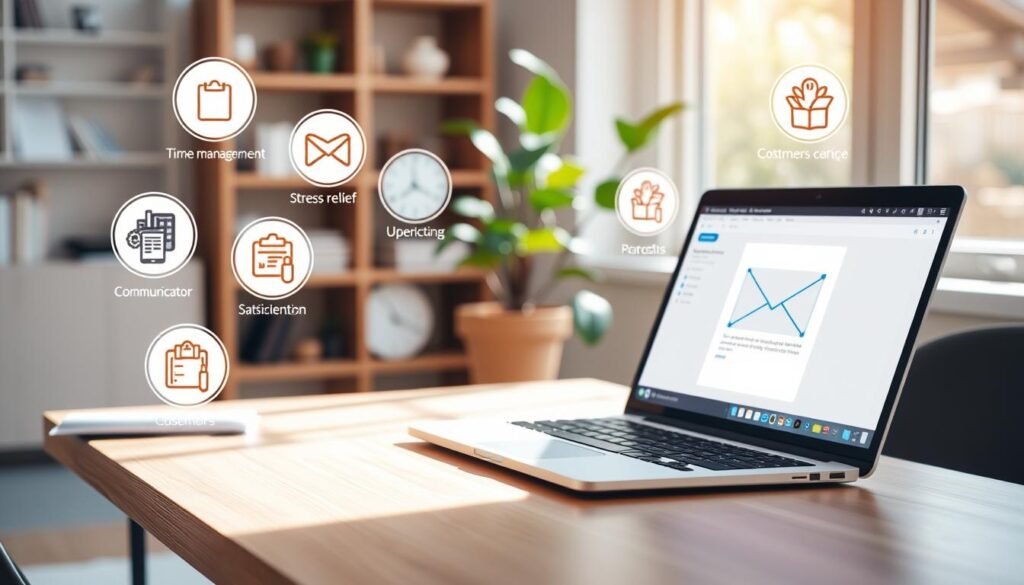
Autoresponders also boost customer service. They can make people subscribe to newsletters or fill out forms. This keeps customers happy and engaged. By setting clear response times and contact options, you avoid making people wait too long.
Customizing auto-replies is another big plus. You can send out specific files or offers that meet customer needs. This shows you care and helps build brand loyalty.
| Benefit | Description |
|---|---|
| Efficient Communication | Immediate acknowledgment of inquiries to enhance customer satisfaction. |
| Time-Saving Email Management | Reduction of repetitive tasks through automation, allowing for better focus on priorities. |
| Improved Customer Service | Personalized and prompt responses that foster positive customer interactions. |
| Professional Appearance | Maintaining brand integrity by communicating availability and response expectations. |
| Customizable Options | Flexibility to tailor responses to different contexts and individual preferences. |
In summary, auto-reply emails offer many benefits. They boost productivity and help build strong professional relationships through effective communication.
How to Set Up Auto-Reply Emails in Gmail and Outlook: A Step-by-Step Guide
Auto-reply emails make communication easier, especially when you’re busy. Gmail and Outlook both offer great options for automated responses. But, the steps to set them up are different. Knowing these differences helps you choose the best method for your needs.
Understanding the Differences Between Gmail and Outlook Auto-Reply
To set up a Gmail auto-reply, start by clicking the gear icon. You can choose when to send these replies. Gmail lets you send replies to everyone or just your contacts.
Outlook’s auto-reply is called Automatic Replies. It’s available on both Windows and Mac. You can set replies for internal and external emails. Outlook also lets you turn off auto-generated Teams meeting links.
Here are some key differences between Gmail and Outlook auto-replies:
| Feature | Gmail Auto-Reply | Outlook Auto-Reply |
|---|---|---|
| Setup Access | Gear icon in settings | Automatic Replies tab in settings |
| Message Customization | limited options> | Internal and external message differentiation |
| Response Targeting | All or contacts only | Custom criteria like email addresses or keywords |
| Temporal Range | Specific start and end dates | Flexible timing options for sending |
Understanding these differences helps you pick the right auto-responder for you. Each platform offers unique features. This means you can manage your emails in a way that suits you best.
Setting Up Auto-Reply in Gmail
Setting up auto-reply in Gmail makes email management easier. It’s great for handling sales inquiries, job applications, or customer questions. I’ll show you how to enable templates, create custom responses, and set up filters for auto-replies.
Enabling Templates in Gmail
To start, I need to turn on the Templates feature in Gmail. I go to the settings menu and choose the Advanced tab. Turning on Templates lets me make email templates for automated responses. This makes quick responses easier and keeps my communication consistent.
Creating an Auto-Reply Template
Now, I’ll make a Gmail auto-reply template. I write a new email with a message that shows my style and professionalism. After writing, I save it as a Template for later use. Making the email response my own helps the recipient feel valued and boosts my response rate.
Setting Up a Filter for Auto-Replies
With my template ready, I’ll set up a filter for auto-replies. I look for specific keywords or sender addresses in the filter settings. By linking my template to these conditions, only the right senders get my automated reply. This keeps my replies relevant and cuts down on junk emails in my inbox.
Setting Up Auto-Reply in Outlook
When I’m away from my desk, the Outlook automatic replies feature is a big help. It lets me tell people I’m not around and gives them the info they need. I can turn it on easily from the File menu.
Using Automatic Replies Feature
To use the Outlook automatic replies feature, I go to the File menu and choose automatic replies. Turning it on lets me write a message for my contacts. It’s great because I can set up auto-replies that fit my schedule.
Configuring Date Ranges and Messages
Setting up automatic replies in Outlook is useful because I can pick when they go out. For example, if I’m on vacation, I can make sure my contacts know. I can also send different messages to people inside and outside my company. This keeps things professional and lets everyone know when to expect a reply from me.
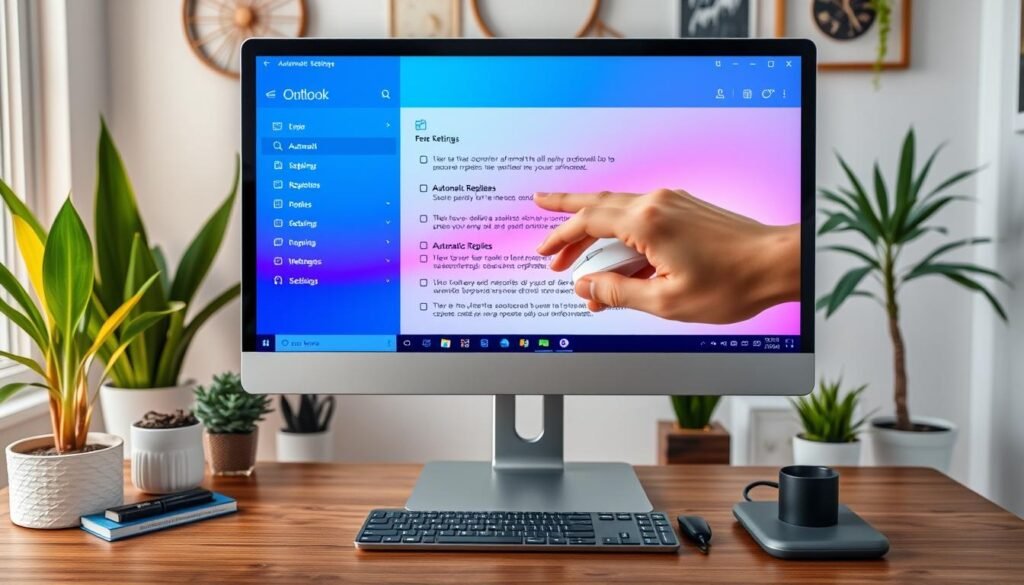
Additional Auto-Responder Setup Options
Using Gmail and Outlook for auto-replies is key. They offer advanced options that go beyond basic replies. This lets me send replies only to my contacts, focusing on important emails.
Both platforms have unique email automation features to boost productivity. For example, Gmail lets me set out-of-office replies based on criteria. This makes my messages more personal for each recipient.
Outlook also has advanced features, like Automatic Replies. It lets me send replies from different accounts efficiently. Learning these options helps me respond faster, even when I’m not checking my inbox.
The table below shows some main features of advanced auto-responder options in Gmail and Outlook:
| Feature | Gmail | Outlook |
|---|---|---|
| Custom Replies | Allowed for specific contacts | Send replies from multiple accounts |
| Spam Filtering | No replies to spam or mailing lists | Allows replies based on filters |
| Duration Set-Up | Manual or auto-off on specified date | Quick toggle for activation |
| Mobile Access | Available on iPhone and Android | App support for replies |
Knowing these email automation features helps me keep my inbox clean. I use vacation responders and custom templates to make my responses quicker and more efficient.
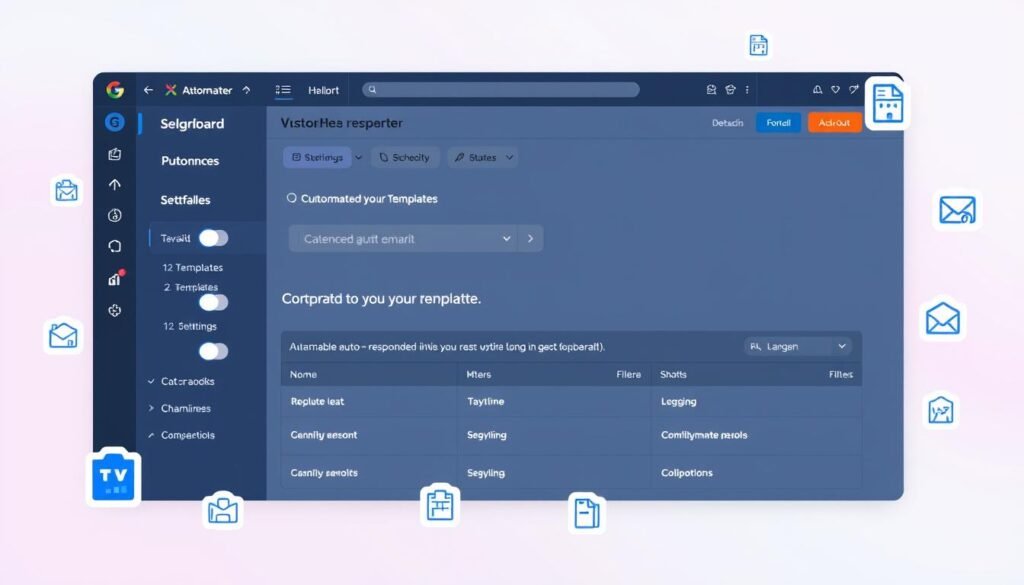
Best Practices for Writing Auto-Reply Messages
Creating effective auto-reply messages is key to professional email responses. A clear auto-reply lets the sender know their email was received. Here are some top tips to follow:
- Be clear and concise: Keep messages short. Focus on the main points to help the recipient understand quickly.
- Maintain professionalism: Use a polite tone. Your language should show your brand’s values, making you look competent.
- Provide alternative contacts: If urgent, point senders to other contacts or resources. This is very helpful when quick help is needed.
- Customize your responses: Make auto-replies fit the situation, like when you’re on vacation. Personal touches can make a good impression.
- Include essential information: State your working hours, when you’ll reply, and any self-help resources. Being open helps keep communication smooth.
- Proofread your message: Check for spelling and grammar errors. A well-written auto-reply shows you’re professional.
- Utilize templates: Use standard auto-replies to save time. This keeps your messages consistent.
By using these strategies, your auto-reply messages will be effective and professional. These practices improve communication, especially when you get a lot of emails.
Troubleshooting Common Auto-Reply Issues
Setting up auto-replies can seem easy, but many users face problems. Issues like an automatic reply not working in Outlook are common. These problems can stem from several causes, like corrupted Out of Office (OOF) rules or settings that block OOF messages.
When auto-replies don’t work, start by checking the OOF settings in Windows PowerShell. If that doesn’t help, try using MFCMapi to reset OOF rules. Also, increasing the rules quota can help with sending auto-replies.
It’s important to filter junk emails from auto-replies in Outlook. Make sure auto-replies aren’t sent to outside addresses in some Exchange setups. Also, watch out for auto-reply loops that keep sending the same message.
OOF rules come in three types: Internal, External, and Known Senders. Knowing this can help you find the source of problems. OOF messages are sent only once to each recipient, keeping the mailbox organized.
Check if transport rules or SMTP forwarding are blocking your auto-replies. Spam messages can stop auto-responses, causing confusion. Sometimes, looking at settings like JournalingReportNdrTo can reveal misconfigurations that affect OOF.
Conclusion
Setting up auto-replies is key for keeping communication smooth, especially when you’re not around. By following the steps for Gmail and Outlook, I can send out automatic replies. These replies let people know I got their message and show I’m professional.
Using Gmail’s templates or Outlook’s custom rules helps me respond faster. This makes my work more efficient. With these tools, I can avoid missing important messages and keep my emails flowing, even when I’m not at my desk.
Learning how to set up auto-replies changes how I handle emails. It makes my email management better and more suited to my business. Adopting these strategies helps me create a reliable system for my contacts. It also adds a level of professionalism that’s crucial in today’s digital world.
